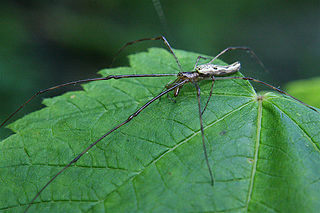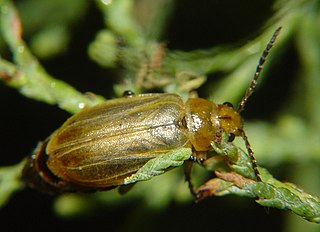
The elongated tortoise is a species of tortoise found in Southeast Asia and parts of the Indian Subcontinent, particularly Northeast India.
Ulmus elongataL. K. Fu & C. S. Ding , also known as the long raceme elm in the US, is a deciduous tree endemic to broadleaf forests in the eastern provinces of China.

The snaggletooth shark, or fossil shark, is a species of weasel shark in the family Hemigaleidae, and the only extant member of the genus Hemipristis. It is found in the Indo-West Pacific, including the Red Sea, from southeast Africa to the Philippines, north to China, and south to Australia, at depths from 1 to 130 metres. This shark can be found near the bottom of the water column of coastal areas, but can be found at continental and insular shelves. Its length is up to 240 cm (7.87 ft). Despite being only vulnerable to extinction, this shark is very rarely seen.
Hemipristis is a genus of weasel sharks, family Hemigaleidae. It contains one extant species, the snaggletooth shark and several extinct species.

The elongated shrew is a species of mammal in the family Soricidae. It is endemic to Indonesia.

Virola elongata is a species of tree in the Myristicaceae family. The tree is native to Panama, Guyana, Brazil, Bolivia, Colombia, Ecuador and Peru. It is also found in Suriname. Virola elongata is thin and 7.5–23 m (25–75 ft) tall, sometimes 30 m (98 ft) tall.

Tetragnatha elongata, the elongate stilt spider, is a spider in the family Tetragnathidae.

Mammillaria elongata is a species of flowering plant in the Cactaceae family, native to central Mexico. Growing to 15 cm (6 in) tall by 30 cm (12 in) wide, it consists of densely packed clusters of elongated oval stems, covered in harmless yellow or brown spines, and in spring producing white or yellow flowers. It is among the commonest and most variable of its genus in nature, and is a popular subject for cultivation. It has gained the Royal Horticultural Society's Award of Garden Merit.

Diorhabda carinulata is a species of leaf beetle known as the northern tamarisk beetle, which feeds on tamarisk trees from southern Russia and Iran to Mongolia and western China. This beetle is used in North America as a biological pest control agent against saltcedar or tamarisk, an invasive species in arid and semiarid ecosystems.

Diorhabda elongata is a species of leaf beetle known as the Mediterranean tamarisk beetle (MTB) which feeds on tamarisk trees from Portugal and Algeria east to southern Russia. The MTB is used in North America as a biological pest control agent against saltcedar or tamarisk, an invasive species in arid and semi-arid ecosystems.

Himanthalia elongata is a brown alga in the order Fucales, also known by the common names thongweed, sea thong and sea spaghetti. It is found in the north east Atlantic Ocean and the North Sea.
Cneoglossidae is a family of beetles, in the large suborder Polyphaga.
Ellobiopsis is a genus of unicellular, ectoparasitic eukaryotes causing disease in Gómez F, López-García P, Nowaczyk A, Moreira D (2009). "The crustacean parasites Ellobiopsis Caullery, 1910 and Thalassomyces Niezabitowski, 1913 form a monophyletic divergent clade within the Alveolata". Syst. Parasitol. 74 (1): 65–74. doi:10.1007/s11230-009-9199-1. PMID 19633933.. This genus is widespread and has been found infecting copepods from both marine and freshwater ecosystems. | classis = [[ parasitism has been seen to interfere with fertility in both sexes of copepods.
Brassica elongata, the elongated mustard or long-stalked rape, is a species of the mustard plant that is native to parts of Central Europe, Eastern Europe, the Balkan Peninsula, the Caucasus, Morocco and parts of Central Asia. Through plant invasion this species has become naturalized in many other parts of the world. Some of these naturalized regions include South Africa, North Western Europe, Australia and North America. Given the wide range of climate and ecological conditions of these regions, B. elongata has been able to disrupt the ecosystems of their native plant habitats and has been label as an invasive species in many of its naturalized zones. In North America, this species is often found as a roadside weed in the southwestern states, particularly in the state of Nevada. Studies allude that the Cruciferae might have migrated through the Bering land bridge from what is now Central Asia. Commonly known as the long-stalked rape or as langtraubiger Kohl in German, this species is a close cousin to Brassica napus (rapeseed) and a secondary genetic relative to B. oleracea (kale). As a close genetic species of the rapeseed, the long-stalked rape has one of the highest counts of accumulated polyunsaturated linoleic and linolenic acid. Both compounds are heavily used to manufacture vegetable oils. Brassica elongata has the propagative potential of turning into a horticultural product from what is currently a noxious weed.

Cattleya elongata, the Cattleya with the Elongated Stalk, is an orchid species in the genus Cattleya endemic to the campo rupestre vegetation in northeastern Brazil.

Pterolophia is a genus of longhorn beetles of the subfamily Lamiinae, containing the following species:
Solidago elongata, commonly called West Coast Canada goldenrod or Cascade Canada goldenrod, is a North American species of flowering plants in the sunflower family. It is native to western Canada, western United States, and northwestern Mexico, primarily in British Columbia, Washington, Oregon, California, and Baja California, with a few populations in Nevada and Idaho. It grows in the Coast Ranges, the Sierra Nevada, the Cascades, and other mountain ranges in the region.
Pterolophia instabilis is a species of beetle in the family Cerambycidae. It was described by Per Olof Christopher Aurivillius in 1922. It is known from Seychelles.
Myrabolia is the only genus in the beetle family Myraboliidae. It has about 13 species, found in Australia.
Leptopentacta elongata is a species of sea cucumber in the family Cucumariidae. It is found in the northeastern Atlantic Ocean and parts of the Mediterranean Sea. It is an infaunal species, occupying a burrow in the seabed, from which its anterior and posterior ends project.











